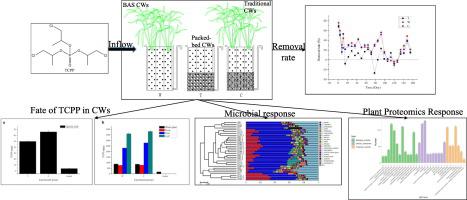Science of the Total Environment ( IF 8.2 ) Pub Date : 2020-08-11 , DOI: 10.1016/j.scitotenv.2020.141668 Pan Qin 1 , Shaoyong Lu 1 , Xiaohui Liu 2 , Guoqiang Wang 3 , Yunxiao Zhang 4 , Deliang Li 5 , Zhengfen Wan 5

|
In this study, three types of constructed wetlands (CWs) (biofilm-attachment-surface-CWs, packed bed-CWs and traditional-CWs) were assembled to comparatively evaluate their ability and mechanism to remove tri-(2-chloroisopropyl) phosphate (TCPP) under continuous flow operation. The removal rate (26%–28%) of TCPP in two types of CWs containing plants was twice as much as that in plant-free CWs in 6-month experiments, and TCPP showed a terminal accumulation phenomenon in Cyperus alternifolius with the order of accumulation of leaf>stem>root. The mass balance indicated that the contributions of filler and hydrophyte absorption to TCPP removal were less than 1%, but the transpiration of hydrophytes may make an important contribution (approximately 10%) to TCPP removal. Species in the genera Massilia, Denitratisoma and SM1A02 may be responsible for TCPP biodegradation. In addition, the effect of TCPP on the metabolic pathways and energy generation in the roots of C. alternifolius suggested that TCPP may be transported and utilized through cellular metabolism.
中文翻译:

三种人工湿地对磷酸三(2-氯异丙基)酯(TCPP)的去除。
在这项研究中,组装了三种类型的人工湿地(CWs)(生物膜-附着表面-CWs、填充床-CWs 和传统-CWs)以比较评估它们去除三(2-氯异丙基)磷酸盐的能力和机制( TCPP)在连续流操作下。在6个月的实验中,TCPP在两种含有植物的CWs中的去除率(26%~28%)是无植物CWs的两倍,并且TCPP在Cyperus alternifolius中表现出末端积累现象,顺序为叶堆积>茎>根。质量平衡表明填料和水生植物吸收对 TCPP 去除的贡献小于 1%,但水生植物的蒸腾可能对 TCPP 去除做出重要贡献(约 10%)。属种Massilia、Denitratisoma和SM1A02可能负责 TCPP 生物降解。此外,TCPP 对C. alternifolius根部代谢途径和能量产生的影响表明 TCPP 可能通过细胞代谢进行运输和利用。


















































 京公网安备 11010802027423号
京公网安备 11010802027423号